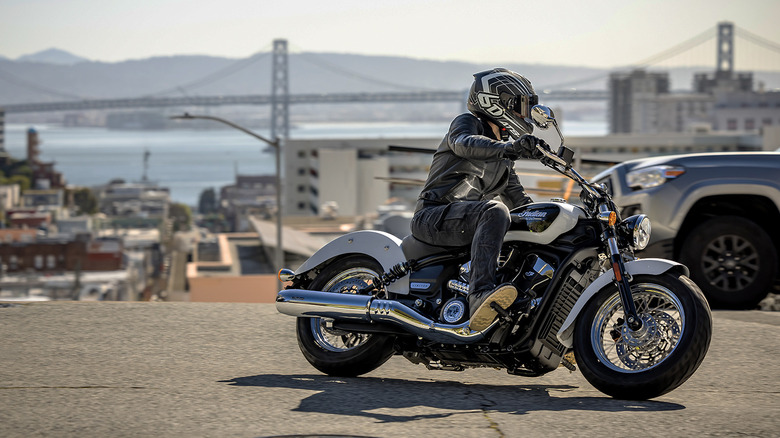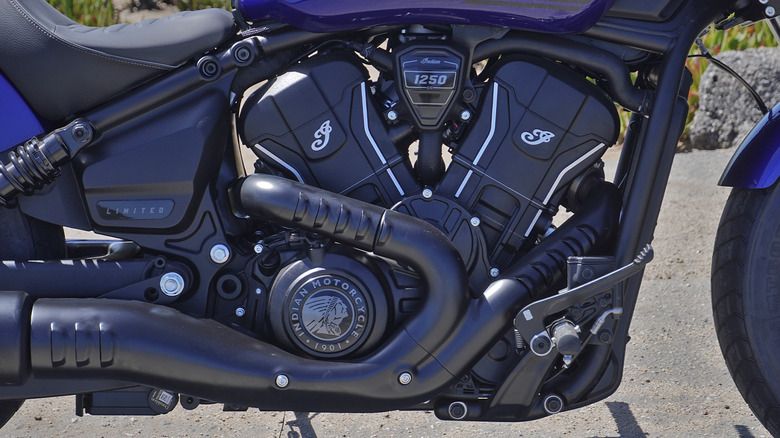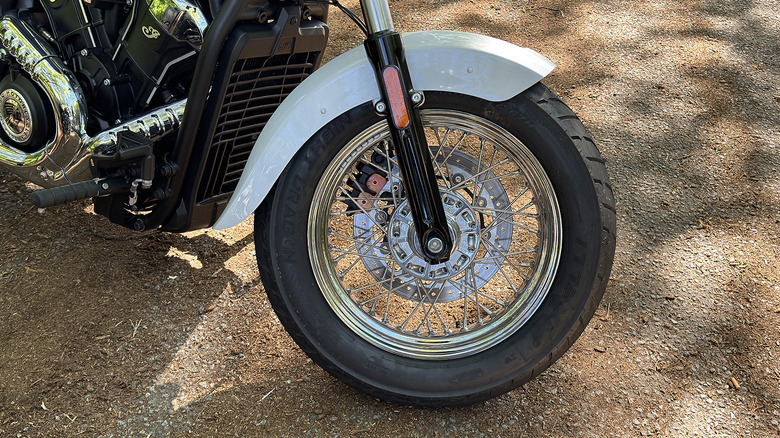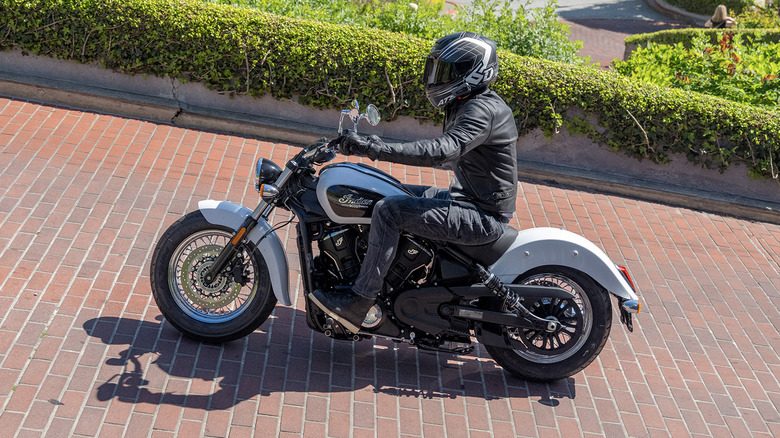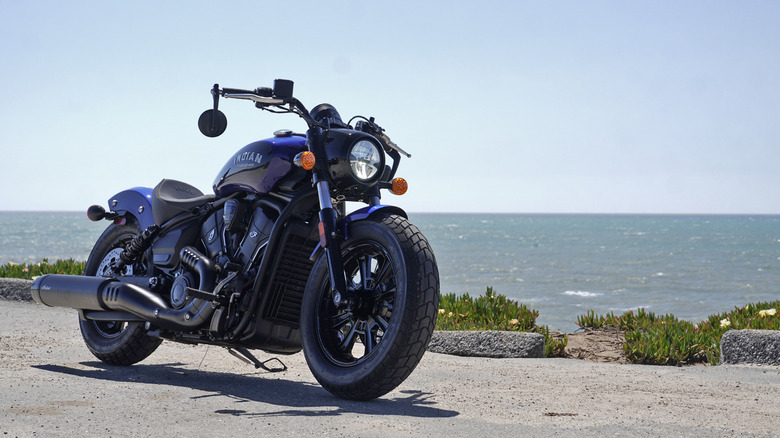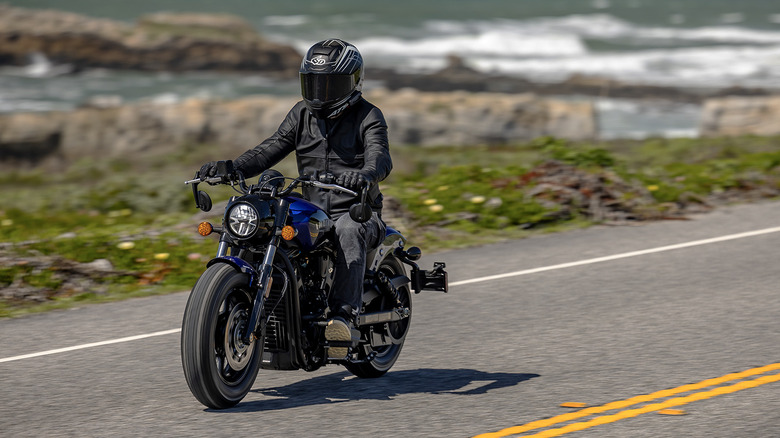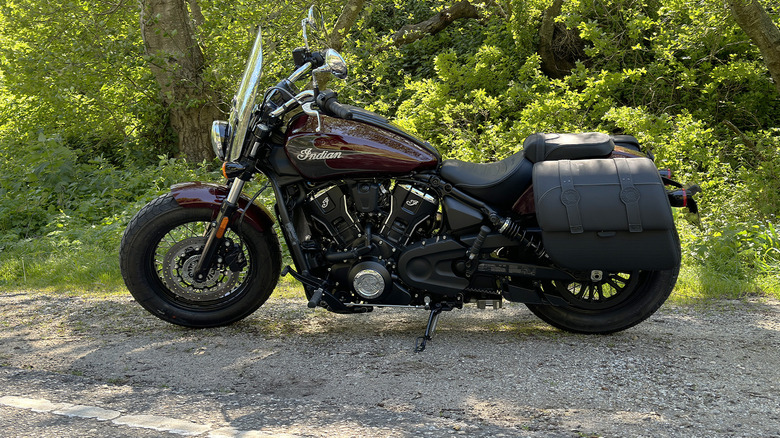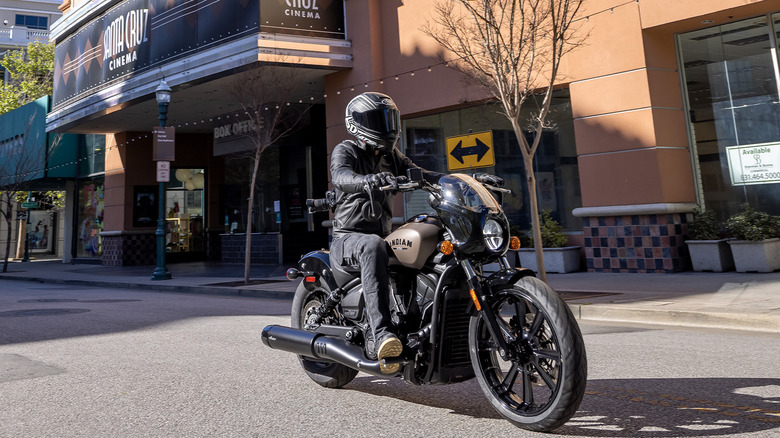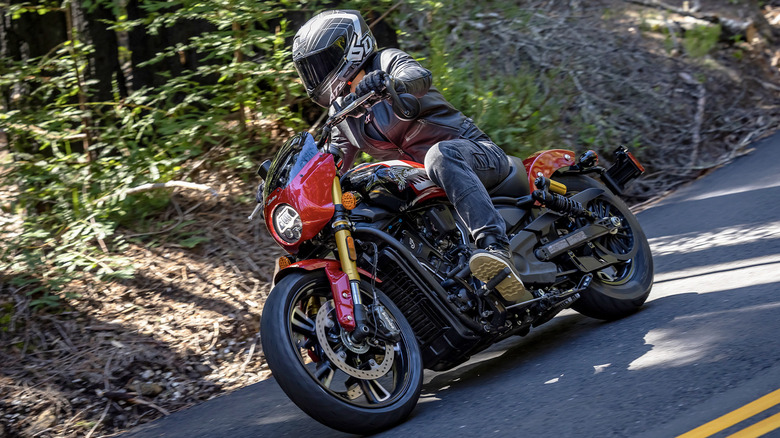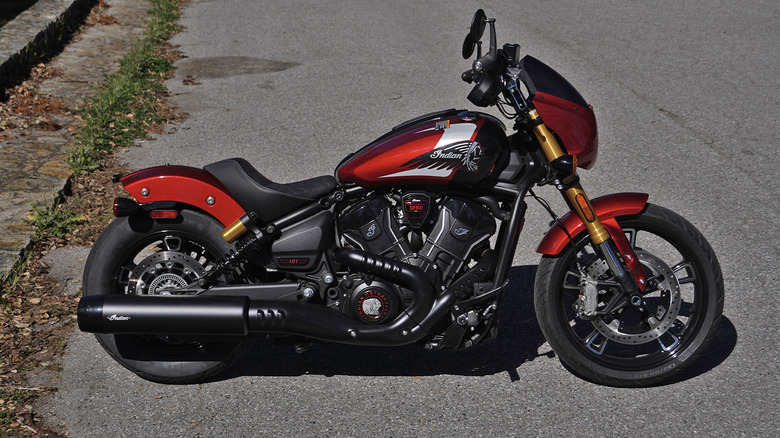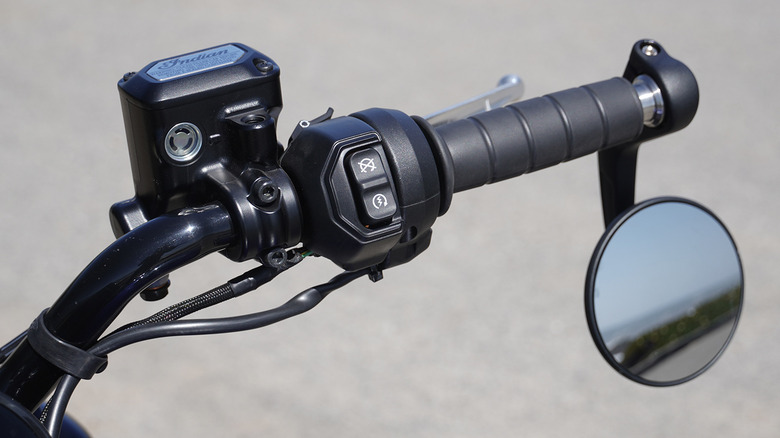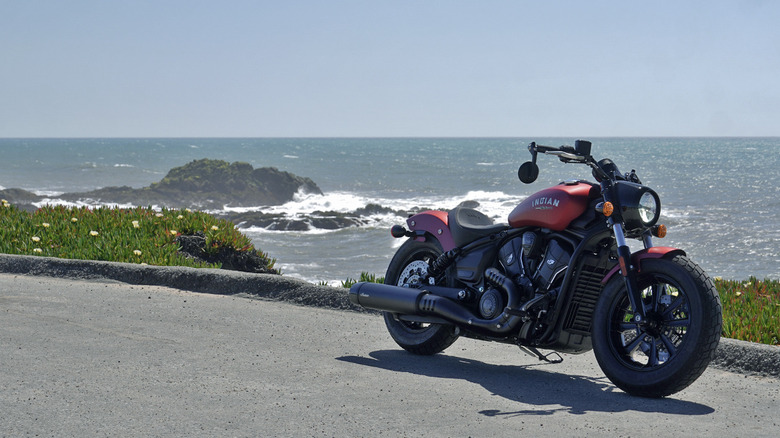2025 Indian Scout First Look: New Gateway To Cruiser Life Comes With Style And Stalls
Indian's recently press launch of the all-new 2025 Scout lineup provided my first real extended exposure to cruiser bikes. In my mind, cruisers always called up Terminator 2: Judgment Day or Sons of Anarchy, or a crew of Hell's Angels road-tripping in formation across South Dakota or Kansas. The image typically involves sparkling black bikes bedecked in bright chrome, riders vested and helmetless, probably a handlebar mustache or two, hogs chugging along with big thumping power and soft suspension, comfortable on low seats while, you know, cruising!
But then I recently rode a Honda Rebel 500, which surprised me in almost every regard. Was this the real cruiser spirit that my imagination never accurately conjured up, all lightweight and nimble and low-slung with tight suspension and touchy handlebars? Surely not... But the Rebel left me quite curious, wondering what to expect as I flew up to the San Francisco Bay Area for two long days of riding at Indian's largest press launch ever, featuring five different variants of the Scout including a revival of the legendary 101 moniker from nearly a century ago.
Truly all-new everything
For the modern Scout's second generation, Indian under Polaris ownership needed to go big or go home. And in this case, the "all-new" designation truly withstands the test of journalistic skepticism: The new Scout boasts a new tube-steel frame, new engine, new midframe, new subframe, new seats, new tank, new tank consoles, new risers, new forward and mid foot controls, a new radiator, new exhaust, new fenders, and newly modernized electronics.
And that's not even the full laundry list! Building the new Scout almost entirely from scratch gave Indian the opportunity to further expand the lineup (without diluting its reputation for affordable maintenance), aiming to better serve every possible cruiser customer in the hopes of continuing to gain in market share against the company's main rivals over at Harley-Davidson.
Adapting to cruisers on the Scout Classic
The first bike I rode probably fits my imaginary cruiser aesthetic best, the Scout Classic that starts at $13,999 and comes with plenty of chrome as well as swooping fenders front and rear. I swung a leg over the low seat and wiggled my hips to acclimate as quickly as possible to the bike's low center of gravity. But this also served as my first intro to forward controls, as opposed to the Rebel's mid controls that I found cramped and awkward. Instead, my feet almost naturally scooted up onto the low pegs, as I tested the ankle angles required to work the gearshifter and rear brake.
The new SpeedPlus 1,250cc V-twin fired up nicely, with a moment of starter whine followed by a relatively quiet purr that reminded me a bit of the Indian FTR 100% R Carbon that I rode last year. Despite the step up in displacement, from 1,133cc for the outgoing bike, and output in stock form jumping to 105 horsepower and 82 lb-ft of torque, I heard none of the expected burly chugga-chugging, perhaps due to the sizable catalytic converter mandated my modern emissions regulations and housed in a massive exhaust pipe behind my right foot. Plastic switchgear on the swept handlebars and Ride Control software on the four-inch circular gauge cluster also felt familiar. As we pulled away into San Francisco traffic, though, the differences started to crop up quickly.
Straight into the fire on a Classic
The hills and cars of SF threw me straight into the fire, in fact. With my hands up high, the Scout's extremely light clutch action, courtesy of a new slipper-assist setup, caused my left hand to struggle at finding the precise friction point where revving the throttle with my right hand synced properly to actually getting the bike underway. I probably stalled three times in the first mile or two, before we even got to the steepest hill, at which point I started revving to around 4,000 rpm after every stop. Meanwhile, the planned photoshoot locations included steep, winding paths where more than a few of my compatriots also stalled out at the front of the chain, requiring some quick negotiation of even tighter turns and causing a few peg drags right out of the gate.
Oh yeah, cruisers aren't sport bikes and turning often requires actually turning handlebars, not just leaning. But after a couple more photoshoots than the ornery residents of SF appreciated, we cruised up to a nice viewing spot below the Golden Gate Bridge, which gave me a few more minutes to adjust to the Scout's riding position.
Onto the best-selling Bobber
Next, I swapped onto a Bobber, the best-seller among the first-generation Scout's variants. Priced at the bottom of the lineup, as befitting the volume seller, a $12,999 Bobber caters best to a crowd looking for blacked-out everything, with a lower ride height and flatter bars than more traditional cruisers (like the Classic). For the second gen, Indian designed the Scout with style very much in mind, prioritizing clean lines and reducing the clutter of thick radiators, exposed electrical wiring, or visible hosing. The Bobber probably looks best in stock form, and surprisingly, I found the geometry of the new bike suited my stature ideally too.
Part of me hoped that swapping onto the Bobber might reduce my struggles with the Classic's clutch. But everyone seemed to be stalling a lot, including Indian reps on hand riding with us. That slipper clutch just left everyone lacking confidence while pulling away, even though Indian added it hoping to reduce the grip strength required for new riders while also improving safety during downshifts or hard braking.
Fiddling with the slipper clutch and Sport mode
When I focused, the issue seemed to center around early feel of the friction zone in the clutch lever's travel, but typical movement and progressive throttle from there simply spins up the engine before the plates compress enough for true engagement. And yet the 1,250cc engine also lacks the low-end torque to pull away with a snappy clutch release, hence the pandemic of stalls hitting our group.
Out on faster country roads further south on the peninsula, I swiped through the Ride Command touchscreen and put the Bobber into Sport mode. Better throttle response throughout the rev range, peppier and more energetic once in motion, also seemed to help me in stop-start situations. And the V-twin also now urged me to rip higher up toward that 9,000 rpm redline, while a few fun sections of twisting road included plenty of turns to purposefully dip low and scrape footpegs—well, after first scraping my foot since I kept my boots heel-down on the forward controls. A few other riders scraped the tail end of the Bobber's exhaust, too, a trade-off for the lowered style that required reducing the rear coilover's total suspension travel by a third.
Superb comfort on the Super Scout
The last portion of our first day of riding took us down Highway 1 overlooking the Pacific Ocean, toward Santa Cruz. Here I thoroughly appreciated my final bike of the day, a fully kitted 2025 Super Scout–the modern-day update to one of Indian's most iconic classics–complete with a tall windscreen and dual saddlebags. The windscreen, especially, kept me in relative comfort as our speeds started creeping up toward and past 80 miles an hour through a fairly stiff crosswind. Here, too, I swiped into Sport mode just for the improved responsiveness given the aerodynamic disadvantage (and my own predilections for riding quicker than, perhaps, our group leader preferred).
The Super also gets taller tires on wire wheels, and after the stiff Bobber, returning back to the Scout's full suspension travel felt noticeably more compliant. The revised two-up seat provided a bit more support for my spine, too, while the long handlebars kept my elbows nearer to my body. In style terms, the Super splits the difference between Classic and Bobber, with plenty of chrome and the longer rear fender but a chopped front. Still, the overall aesthetic definitely leans toward traditional touring thanks to the windscreen and saddlebags.
Meanwhile, the Super also comes only equipped with the Limited + Tech package, which means a push-start button, the digital touchscreen, and configurable accessory buttons on the tank console at the starting price of $16,499. Indian had warned us to expect a pre-production bug that causes the Ride Command digital gauges to take a while to fire up after pushing the start button, but my Super's gauges also froze repeatedly while underway. Hopefully, the system can iron out any glitches before customer deliveries begin, but it is based on Polaris tech, after all. And for such bigger saddlebags, made possible by the redesigned exhaust, locking capabilities and assurances better than just "weather resistant" might be nice...
Sport replaces the Rogue Scout
For the second generation, Indian axed the Scout's Rogue trim and replaced it with the new Sport. I started out on a Sport for the second day of our trip, headed back north toward San Francisco on inland roads that seemed, to me, perfect for a true sport bike. But this model's moniker probably stretches the term a bit, since the Sport essentially serves as something of a more standard package but with a 19-inch front wheel swapped on and a starting price of $13,499.
The main difference I noticed, other than the little windscreen fairing that blocked a bit of buffeting—but not much—came through my sense of touch. Somehow this bike felt more substantial, with deeper engine reverberations and more road feel than the previous day's rides. I suspected maybe an overnight ECU tune snuck in for good measure but decided, in the end, that the six-inch risers holding the handlebars more rigidly probably explain the difference. The risers seemed to absorb less of engine and vibrations than the longer, more curved bars from the previous day. Or, maybe my level of tiredness had increased after about eight hours in the saddle the day before and I was sensing the lower front tire sidewall. But either way, I welcomed the sensation to feel a bit more engagement as the quality of roadways and the group's pace also stepped up noticeably.
Taking the 101 into San Francisco
Fittingly, my last bike of the two-day adventure sat at the top of the new Scout's gradewalk. I looked forward to testing the 101 trim, named after the iconic freeway but also a historical Scout model that Indian sold from 1928-31 before the Great Depression killed off the top-spec bike. The 101 is, to an extent, the most powerful Scout, with 111 ponies on tap as standard, but a standalone ECU tune will be available for purchase via a dealer flash on all new 1,250cc Scouts to match that figure, too.
In terms of style, two unique paint-jobs differentiate the 101 from the Sport Scout, but more importantly, the 101 comes with gold-painted inverted forks and piggyback rear shocks to both stand out from the crowd and help soak up more road imperfections. Like the Super, the 101 always includes the Limited+Tech package at a $16,499 MSRP.
The extra power seemed to help me pull away from stops on the 101, and though the gold dampers suggest, but are not courtesy of, Öhlins, they do make a big difference in terms of ride quality. Little cracks and lines in the asphalt, even smaller pebbles and wavier portions all evaporated from my consciousness. Now, I only needed to keep an eye out for big potholes or roots, while the level of stability through corners only increased my frequency of dragging the pegs. And all of a sudden, dual Brembo front brake discs reminded me how much work my right hand had been doing on all the other, less generously equipped Scouts.
General thoughts across the Scout lineup
Bringing back the 101 package hints at Indian's confidence for the new Scout, which already situates into the overall lineup as the best-selling model and most common entry point for buyers new to the company. Cleaning up the design, adding modern tech that includes standard ABS and traction control, while increasing the variance among potential Scout purchases should, theoretically, only help the Scout continue to bolster Indian's upswing in the cruiser market.
Unfortunately, some of the little details need a bit of ironing out—and I suspect not just in terms of pre-production flaws. I needed to futz with one headlight housing to properly align it with the handlebars and forks, as well as multiple turn signals installed at haphazard angles. Not great that they all moved with minimal effort required.
The light clutch is a sales and safety point but also definitely a serious bummer, combining with the single front brake disc on every Scout but the 101 to produce a disconcerting disconnect between the weight of the bike itself and the seemingly insubstantial drivetrain. But the 1,250cc V-twin isn't insubstantial, is the thing. The lack of chain noise might contribute to that inkling, since Indian went the belt drive route along with Harley (and speaking of, when I inspected the belt itself—so reminiscent of Polaris side-by-sides—I also noticed a piece of critical-looking electronics with a wire plugged into it, dangling below at just about the lowest single part of the bike other than tires).
Indian built the new Scout very purposefully
I hold out hope that swapping on a new exhaust will not only open up a bit more power from the V-twin, but also imbue some more of that traditional chopper spirit throughout the physical experience of riding the new Scout. And Indian fully expects customers to customize their Scouts immediately. Hence the huge list of accessories available straight from the factory, as well as the decision to return to a steel frame rather than the previous generation's aluminum frame, which many choppers hesitated to cut up.
Even though I can now confirm beyond a reasonable doubt that I am decidedly not a cruiser guy, by the end of the Scout launch I started to get into the spirit, pushing forward on my outside pegs to reduce lean angle and drop my center of gravity, rather than hooking straight down on my uphill peg while countersteering into turns. Sliding pipes, watching sparks fly, hauling into full throttle way more frequently than expected—or necessary—our crew of cruisers lane-splitted back into San Francisco traffic ready for some brews and steaks.
But then I returned home and hopped on a couple of more serious sport bikes and remembered what's on the market for similar prices as the Scout's $12,999 starting sticker for a Bobber, all the way up to the asking price for a 101. Remember, those numbers are before accessories or dealer prep or paying a shop to do some quick custom work.
Building my ideal Indian Scout
But of course, the mind wanders and I started piecing together my ideal Scout mod job. Maybe with the right combo, I might get more into the cruiser life. So far, I think a Bobber to start with, plus the ECU tune, of course. But also the smallest blacked-out wire-spoke wheels with the tallest tires possible, maybe a little underinflated to help the rest of the suspension better iron out more road. I'd start without the rear piggyback and see how my spine felt for a bit before deciding on that investment.
I probably want the Sport or 101 fairing, not a big windshield, to shield my helmet a bit more at speed. And no risers, because I want my handlebars as low as possible, so maybe just flatter bars will help provide some of that rigidity I found lacking. At a shop, I'd swap on a quick straight pipe to replace the catalytic converter, since even California doesn't smog test motorcycles. And I'd ask what they can do to adjust the clutch, or even figure out a way to remove the slipper assist and just use standard discs to improve bite and feel.
As I type out my expanding plan for a dream Scout build, all of a sudden I'm smiling—partly at the prospect of a cool bike but partly a wry grin at how much, just maybe, I actually enjoyed the ride. Did cruiser bikes pull an Inception on me? Should I have turned to the Scout 101 as I handed over the keys for a final time and said, "Hasta la vista, baby"? Or should it have been an "I'll be back"? After two awesome days cruising down and then back up the San Francisco peninsula, part of me thinks I might end up leaning more likely to the latter.
